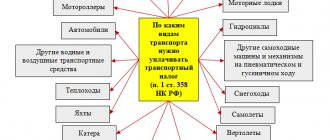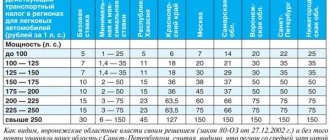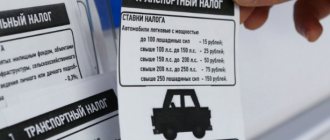The procedure for calculating transport tax for an incomplete year
Date of publication: 06/18/2013 09:28 (archive) The Office of the Federal Tax Service for the Lipetsk Region explains that in accordance with Articles 14 and 356 of the Tax Code of the Russian Federation (hereinafter referred to as the Code), transport tax is a regional tax, which is established by the Code and the laws of the constituent entities of the Russian Federation on tax, is put into effect in accordance with the Code of laws of the constituent entities of the Russian Federation on tax and is obligatory for payment on the territory of the corresponding constituent entity of the Russian Federation. On the territory of the Lipetsk region, the transport tax is established “On transport tax in the Lipetsk region” (hereinafter referred to as Law 20-OZ). According to Article 362 of the Code, the amount of tax payable to the budget at the end of the tax period is calculated for each vehicle as the product of the corresponding tax base and tax rate.
Rates depending on the power and category of the vehicle are established by Law 20-OZ. Paragraph 3 of Article 362 of the Code establishes that in the event of registration of a vehicle and (or) deregistration of a vehicle (deregistration, exclusion from the state ship register, etc.) during the tax (reporting) period, the tax amount is calculated from taking into account the coefficient, defined as the ratio of the number of full months during which the vehicle was registered to the taxpayer to the number of calendar months in the tax period.
In this case, the month of registration of the vehicle, as well as the month of deregistration of the vehicle, is taken as a full month. Thus, when registering a vehicle, for example, on May 15, 2012, the tax is calculated for 8 full months (104 hp x 28 rubles / 12 x 8 = 1941.33 rubles). Dear taxpayers! You can calculate transport tax in the Lipetsk region using the regional service. A taxpayer can find out about rates and benefits for transport tax by using the service "". Share:
Calculation of transport tax and advance payments
The calculation of transport tax and its features are defined in Chapter 28 of the Tax Code of the Russian Federation. Federal legislation sets out the general provisions of the law. And transport tax rates, payment deadlines, tax benefits and discounts are adopted by the legislative bodies of the constituent entities of the Russian Federation.
Calculation of transport tax
Transport tax is calculated for cars and other vehicles equipped with an engine using the formula:
TN = (Tax rate) x (engine power (hp)) x (tenure period)
The tax rate is set by regional legislation depending on engine power.
Engine power for vehicles is indicated in horsepower. The vehicle registration certificate almost always indicates the power in hp. and kilowatts. If necessary, you can convert kilowatts to horsepower: 1 kW = 1.35962 hp.
For example: 77.3 kW. X 1.35962 = 105 hp
The vehicle ownership period for a whole year is taken as one. If the vehicle is not fully owned during the year, the ownership period is equal to the number of months of ownership divided by 12.
For example: - a car is registered in May, the ownership period is 8/12. — the car was registered in September and deregistered in December, the ownership period is 4/12.
The calculation of transport tax for the year will look like this.
For example: RENAULT car with 75 hp. purchased and registered with the State Traffic Safety Inspectorate in February 2012. The tax rate in the region is 7 rubles.
Tax amount for 1 sq. 2012 = 75 hp x 7 rub. x 2/12 = 87.5 rub. Tax amount for Q2 2012 = 75 hp x 7 rub. x 3/12 = 131.25 rub. Tax amount for Q3 2012 = 75 hp x 7 rub. x 3/12 = 131.25 rub.
Tax amount for Q4 2012 = 75 hp x 7 rub. x 3/12 = 131.25 rub.
Tax and advance payment are paid in whole rubles without kopecks, taking into account rounding.
You can find out the transport tax rate in your region on the website: https://zakon-auto.ru/info/nalog.php
Timing and procedure for tax payment
Taxpayers - legal entities calculate and pay advance tax payments independently for each quarter. The payment deadline for them is within 30 calendar days after the end of the quarter. Tax for the year must be paid by February 1 of the following year.
KBK transport tax – 18210604011021000110
Transport tax for individuals is calculated by the tax office at the place of vehicle registration, but you can also calculate it yourself. Individuals pay tax once a year, but not earlier than November 1. You can find out your tax debt in your personal account on the tax inspectorate website nalog.ru.
Individual entrepreneurs are classified as individuals and the transport tax code for them is 18210604012021000110.
Tax return
The tax return is submitted to the Federal Tax Service once a year before February 1 of the following year. Starting from reporting for 2012, a new form of tax return for transport tax was approved. In the new form, in Section 1, additional fields are introduced for “amounts of advance payments calculated for payment” for the 1st, 2nd, and 3rd quarters of the reporting year.
It is now possible to indicate the “ecological class”, the age of the car and apply several tax benefits (if necessary). Calculation for each vehicle is now carried out on a separate sheet.
So, after reading this article, you can independently calculate the transport tax
How to calculate transport tax for an incomplete year
Data on vehicle owners comes from the registration authorities to the tax office automatically (without the direct participation of the car owner).
Moreover, new data (on deregistration or registration of a vehicle) must be provided within 10 days from the date of the corresponding operation and confirmed at the end of the reporting period (December 31, since the reporting period is considered a year). Transport tax is calculated using the formula: Amount payable = tax base * tax rate * Kv, where
- Kv is a coefficient depending on the number of months of actual use.
- tax rate - determined by the regional law on transport tax;
- tax base - calculated in horsepower or other units that determine the power of the vehicle;
The coefficient can be decreasing if the vehicle was in the owner’s possession for less than 1 year and increasing (applied to vehicles worth more than 3 million rubles). If a person owned a car for less than 1 year, then Kv is defined as the ratio of the months of use of the vehicle to 12, that is, to the total number of months in a year.
For example, a car was registered on October 3. The actual usage time is 3 months, and the coefficient will be 3/12=0.25. All information about the calculation of transport tax is contained in the tax notice sent to the car owner by mail.
The same document also contains the date before which the tax must be paid. Transport tax for an incomplete month for a legal entity is calculated according to the same principle as for citizens.
Transport tax for legal entities.
Legal entities that own cars, buses, motorcycles, yachts, helicopters and other vehicles are required to pay transport tax.
Independent calculation of this tax, the procedure for paying it to the budget and filing a tax return often cause serious difficulties for company accountants.
In this article we will consider in detail the main elements of taxation with transport tax paid by legal entities.
Taxpayers
The Tax Code includes legal entities that are owners of various types of transport as transport tax payers. This means that if a vehicle that is subject to taxation is registered to a company, then it must pay tax on the basis of Article 357 of the Tax Code of the Russian Federation.
The legislation establishes certain categories of organizations that are exempt from paying transport tax. These include, in particular, enterprises associated with the organization of world-class sporting events.
The object of taxation is a fairly wide range of vehicles. These are cars, buses, scooters, motorcycles, airplanes, helicopters, yachts, boats, snowmobiles and other types of transport.
Clause 2 of Article 358 of the Tax Code of the Russian Federation defines a closed list of preferential movable property. For example, transport tax is not paid by legal entities that own cars intended for the disabled, rowing boats, tractors, air ambulance planes and helicopters, and some other types of transport.
Transport tax rates
The main base rates of transport tax are established by Article 261 of the Tax Code of the Russian Federation. Since the tax is regional, each subject of the federation has the right to set its own tax rates approved by regional laws. Therefore, transport tax rates may differ in different regions.
However, if the legislation of the relevant subject does not introduce its own tax rates, then the basic norms of the Tax Code of the Russian Federation apply.
The criterion for determining the tax rate is the type of vehicle and the power of its engine in horsepower. Since there are quite a lot of types of transport subject to tax, as an example we will give the transport tax rates for the most popular objects of movable property, which are most often owned by legal entities.
As a rule, many businesses own at least one passenger car. Depending on the make and model, vehicles have different engine sizes, which can be found out by looking at the passport of the corresponding vehicle.
Tax legislation divides passenger cars into 5 large categories, starting with an engine capacity of less than 100 horsepower and ending with an engine capacity of 250 horsepower.
Accordingly, transport tax rates for passenger vehicles vary from 2.5 to 15 rubles per 1 horsepower. For example, the least powerful cars with a small engine capacity (less than 100 hp) are taxed at a rate of 2.5 rubles. for 1 hp, more powerful vehicles with engine capacity from 100 to 150 hp.
Transport tax for less than a month of ownership
The payment procedure itself is prescribed in the tax law, and municipal authorities determine the amount of the tax rate, the increasing coefficient, as well as the conditions and amount of benefits for car owners. The object of taxation is vehicles, including land, water and aircraft, both self-propelled and trailers.
But do not forget that the fee is also imposed on owners of boats, motor sleds, motor boats and jet skis.
Is there an obligation to pay a fee in case of car theft?
After all, only the documentary ownership of the car remains, and the owner cannot physically dispose of it. Rules for calculating and paying transport tax for.
It is allowed not to make a payment when the theft of the car is documented.
Calculation of transport tax when deregistering a car. This document is issued either by the police or the investigative committee, which is directly involved in searching for the car and investigating the incident. Resolutions from these structures must be submitted to the Federal Tax Service so that the tax is not calculated from the date of theft.
There are reasons why the owner does not use the car; the most common examples are: the car was driven to an impound lot, the driver was deprived of his license, the vehicle is being preserved in a garage or undergoing long-term repairs.
How to pay transport tax in this case?
The logic is simple: since according to the documents you are still the owner of the car, then the obligation to pay for it remains unchanged.
The fact that the car is idle does not matter in this case.
Procedure and rules of accrual
How is transport tax calculated for less than a month?
Data on vehicle owners comes from the registration authorities to the tax office automatically (without the direct participation of the car owner). Moreover, new data (on deregistration or registration of a vehicle) must be provided within 10 days from the date of the corresponding operation and confirmed at the end of the reporting period (December 31, since the reporting period is considered a year).
Transport tax is calculated using the formula: Amount payable = tax base * tax rate * Kv, where
- Kv is a coefficient depending on the number of months of actual use.
- tax base - calculated in horsepower or other units that determine the power of the vehicle;
- tax rate - determined by the regional law on transport tax;
We recommend reading: Bank statement for residence permit
The coefficient can be decreasing if the vehicle was in the owner’s possession for less than 1 year and increasing (applied to vehicles worth more than 3 million rubles). If a person owned a car for less than 1 year, then Kv is defined as the ratio of the months of use of the vehicle to 12, that is, to the total number of months in a year.
For example, a car was registered on October 3. The actual usage time is 3 months, and the coefficient will be 3/12=0.25.
All information about the calculation of transport tax is contained in the tax notice sent to the car owner by mail. The same document also contains the date before which the tax must be paid.
Transport tax for an incomplete month for a legal entity is calculated according to the same principle as for citizens.
Methodology for calculating the “luxury” transport tax
Since the beginning of 2014, the transport tax on passenger cars worth over 3 million rubles. calculated using increasing factors. Individual taxpayers will see the amount received in the notification that the tax authority will send to them in 2015. Organizations will have to carry out the “luxury” calculations on their own.
The issue of introducing a luxury tax has been raised since 2003. The State Duma has more than once received bills providing for the introduction of a differentiated personal income tax rate in order to reduce the level of social inequality, but none of them found support from parliamentarians. And in 2012, President Vladimir Putin, addressing his annual message to the Federal Assembly of the Russian Federation, stated that it was impossible to abandon the “flat” personal income tax scale, since progressive taxation of citizens would not ensure social justice. In his opinion, the introduction of progressive taxation will be a burden for millions of people with average incomes. “If you start counting where this will lead, you will see that it will happen. There will be tax evasion and the budget and treasury will receive corresponding amounts of money from this tax. This means that we will have deficits in financing the army, pensions, and the budgetary sector. Therefore, we need to act extremely carefully in this area,” Putin said then. At the same time, he advocated the introduction of a “luxury tax” in the country, emphasizing that the Government of the Russian Federation needs to implement the fundamental decisions taken on the “luxury tax” in the first half of 2013, including luxury real estate and expensive cars.
Initially, it was assumed that luxury real estate and expensive cars would be subject to the luxury tax. However, in the end, it was decided to levy an increased tax so far only on owners of vehicles whose value exceeds 3 million rubles. The corresponding Law of July 23, 2013 N 214-FZ came into force on January 1, 2014.
Systematization of accounting
But the good people from the tax office did not forget - they took the base from the nut, and there it hangs on me. Well, this is all business as usual. The funny thing is that the tax office gave me a receipt with the details of a car that I had never seen.
1. The one who got the documents replaced the body (from a station wagon to a sedan) and, accordingly, replaced the engines.
The wooden station wagon turned into a cool car.
The replacement of all this (installation and removal) was done in 1 day, i.e.
The new car has not been registered with the state for a single day. In general, this is an ordinary money scheme. The replacement took place at the end of June. 2. The tax office issued a receipt for a new car starting in the new year - I was simply stunned, the numbers were an order of magnitude different. It’s time to get angry at them and roll out a harsh cart with data attached from the nut database and the Internet.
The funny thing is that they responded instantly, and it turned out that they still owed me after the recalculation.
So, in such situations it is better to communicate with them in a documented and reasoned manner. They simply must contact the nut and recalculate the tax based on their actual registration.
Author: Ilyukha (St. Petersburg) (194.186.172.—) Date: long ago Hello everyone again!
Yesterday I went to the tax office and received advice from an inspector.
It was like this: in 2004 the Corolla was registered (3 months), then in September I bought a RAV4. It turns out that I didn’t know how the tax was calculated: for example, I registered the car in September 2004, and in 2005 you pay for 4 months of 2004. and for the WHOLE 2005
Accordingly, for 2004
Number of months of vehicle ownership
In short:
- The car is deregistered before the 15th - the month is not taken into account;
- The car is registered before the 15th - transport tax for the full month;
- The car is deregistered after the 15th - transport tax for the full month.
- The car is registered after the 15th - the month is not taken into account;
P.S. Until 01/01/2016, it was considered as follows: the month of registration of a vehicle, as well as the month of deregistration of a vehicle, are taken as a full month.
In case of registration and deregistration of a vehicle within one calendar month, the specified month is taken as one full month. Vehicle ownership rate registration and de-registration in one month Distinctive features are:
- at the end of each year, a declaration is submitted to the tax office containing the procedure for calculating transport tax (for each vehicle separately) with receipts for advance payments attached. The amount of the advance payment is determined as ¼ of the total tax amount.
- Tax payment is made at the end of the reporting period or quarterly (in advance payments). This aspect is regulated by regional laws;
- the need to independently calculate the amount of tax for each vehicle, that is, the tax to be paid is determined by the enterprise’s accounting staff based on data on the vehicle’s power and the tax rate;
Examples of calculation Let's look at examples of calculating transport tax in specific situations.
How is transport tax calculated when owning a car for less than six months?
Example 3 The car was registered on June 23, 2014, the car’s power is 445 hp.
produced by the vehicle in 2013 cost 3,670,000 rubles tax rate in the region is 150 rubles Kv 7/12=0.58 increasing factor 1.3 tax amount 445*150*0.58*1.3=50329.5 rubles Thus , the owner of a car with the specified characteristics must pay a tax in the amount of 50,329 rubles 50 kopecks. Example 4 truck with 210 hp power. the vehicle was purchased and registered in February 2014, the tax rate in the region is 38 rubles, the vehicle ownership period is 11 months, Q 11/12 = 0.92 tax amount 210 * 38 * 0.92 = 7341 rubles 60 kopecks In the regional legislation on transport tax advance payments are provided. In each quarter, the enterprise is obliged to pay 7341.6/4 = 1835.4 rubles.
Attention
Now you know what the maximum amount of transport tax should be. What is needed in order to calculate the amount of transport tax in practice: 1. Find a table of tax rates for your region. I note that regions also have the right to set transport tax rates depending on the year of manufacture of the car.
So in some cases the table will have more columns. 2. Find out the engine power of the car you are planning to purchase. 3. Find out the year of manufacture of the car. 4. Find the appropriate column in the table and multiply the number indicated in it by the engine power of your car. In fact, calculating transport tax is very simple. The main thing is to find the right table with bets. Well, after receiving the final amount, you can proceed to payment: Attention! For the fines checking service to work correctly, enable JavaScript support in your browser.
What transport tax do you need to pay for less than a month?
As for the tax rate, it is determined for each subject of the Russian Federation and depends on the engine size, year of production and environmental class. An increasing factor is used when calculating the duty for owners of vehicles worth more than 3 million rubles. Their list is determined by the Ministry of Industry and Trade.
A detailed list is on the official website. Please note: it must be published no later than March 1st.
If the technical documentation of the machine indicates the motor power in kW, then it must be converted into horsepower using the equality 1 kW = 1.35962 liters. s., and the result is rounded to two digits.
For example: 100*1.35962=135.96. Please note that individuals must pay the fee by November 1st.
However, it is calculated in full rubles. In other words, a balance of less than 50 kopecks is not taken into account, but more is counted as one ruble.
Recalculation of transport tax for an incomplete year of ownership?
Moreover, new data (on deregistration or registration of a vehicle) must be provided within 10 days from the date of the corresponding operation and confirmed at the end of the reporting period (December 31, since the reporting period is considered a year). Transport tax is calculated using the formula: Amount payable = tax base * tax rate * Kv, where
- tax base - calculated in horsepower or other units that determine the power of the vehicle;
- tax rate - determined by the regional law on transport tax;
- Kv is a coefficient depending on the number of months of actual use.
The coefficient can be decreasing if the vehicle was in the owner’s possession for less than 1 year and increasing (applied to vehicles worth more than 3 million rubles).
If a person owned a car for less than 1 year, then Kv is defined as the ratio of the months of use of the vehicle to 12, that is, to the total number of months in a year. For example, a car was registered on October 3. The actual usage time is 3 months, and the coefficient will be 3/12=0.25.
Important
All information about the calculation of transport tax is contained in the tax notice sent to the car owner by mail. The same document also contains the date before which the tax must be paid. For legal entities Transport tax for an incomplete month for a legal entity is calculated according to the same principle as for citizens.
How is transport tax calculated: formula and nuances
Distinctive features are:
- the need to independently calculate the amount of tax for each vehicle, that is, the tax to be paid is determined by the enterprise’s accounting staff based on data on the vehicle’s power and the tax rate;
- Tax payment is made at the end of the reporting period or quarterly (in advance payments). This aspect is regulated by regional laws;
- at the end of each year, a declaration is submitted to the tax office containing the procedure for calculating transport tax (for each vehicle separately) with receipts for advance payments attached. The amount of the advance payment is determined as ¼ of the total tax amount.
Examples of calculation Let's look at examples of calculating transport tax in specific situations.
That is, for example, the transport tax on the same car may be different in Moscow and in the Moscow region. Therefore, before picking up a calculator to calculate transport tax, I recommend that you check the tax rates in your specific region.
However, I would like to note that in 2021, regions can change tax rates only within certain limits. The numbers from the table above can be increased or decreased, but not more than 10 times.
For clarity, I will provide here another table, which additionally includes the maximum and minimum tax per horsepower. Engine power Minimum tax per 1 hp. Tax amount per 1 HP Maximum tax per 1 HP up to 100 hp
(up to 73.55 kW) inclusive 0 2.5 25 over 100 hp up to 150 hp (over 73.55 kW to 110.33 kW) inclusive 0 3.5 35 over 150 hp up to 200 hp
Second car tax
The tax base for calculating vehicle tax is exclusively properly registered vehicles (Article 357 of the Tax Code of the Russian Federation). Therefore, there is no need to pay tax on a vehicle that is not registered. Difficulty in determining the vehicle category.
The vehicle tax rate depends on its category and capacity. Both parameters are indicated in the PTS and the registration certificate.
To determine the category, you must use the document line about the characteristics of the vehicle, which clearly states the passenger car, truck, bus, and so on. The car was initially purchased on lease, and then registered to the organization.
It is necessary to pay transport tax in a situation where the car was initially registered to the lessee, and subsequently to the owner, only once. In this case, Kv is determined according to the above rules.
How to calculate transport tax in 2021
This rule is contained in Article 52 of the Tax Code of the Russian Federation. You can get an installment plan if you:
- suffered significant damage due to a natural disaster
- received less funding from the state budget
- this could lead to bankruptcy
- are engaged in seasonal activities
- move goods across the border
So, the calculation is influenced by 4 factors: vehicle power, tax rate, increase factor (for luxury vehicles) and number of months of ownership. In this case, the amount of the duty is calculated in full rubles.
Formula for calculating the duty for owning a car Calculate the tax yourself The standard formula for how the transport tax is calculated looks like this: the amount of the tax is equal to the product of the tax rate and the power of the car (hp). In other words, ownership fee = tax rate * vehicle power (hp).
Amendments will be made to the Labor Code regarding labor protection. And are there many believers in this nonsense? The astrologer told how accountants will celebrate the May holidays. That is, if an individual entrepreneur with employees on a patent, he must switch to online cash registers from 02/01/2021? Reminder table for switching to online cash registers We know. We passed.
They forced me to resign (by pressure, intimidation), knowing about my pregnancy! Through... Instead of layoffs, employers are forced by threats to write a statement “on their own” director A, collector A Horror... Alternative ways to liquidate a company: you can’t quit, leave it, St. Petersburg Will they really leave him as Prime Minister? What difference does it make who lies to the people? Uh...
Alternative ways to liquidate a company: you can’t abandon it, leave it Has the bill already been passed? I can’t find the information Reminder table for switching to online cash registers Above.
K, you wrote: Anonymous, well, there is no legal entity without employees, so what? This means there is no one to note this line... Reminder table for switching to online cash registers Anonymous, well, there is no legal entity without employees, so what? This means there is no one to apply this line. But only.
... Reminder table for switching to online cash registers Anonymous, you wrote: is it really impossible to do seasonal work without an online cash register... Who else will be exempt from using cash registers saigak, but not a fact. It’s our accountants who are so “talented” that they hear what they don’t... The buyer on the simplified tax system does not want to allocate VAT in payments Nad.
K, the tax office doesn’t have this drop of knowledge either.
In this case, the month in which the placement/removal took place is counted as a whole month. For example, if you registered on January 31, you deregistered the next day on February 1 - the tax is paid for 2 months.
Transport tax 2021
Russian President Vladimir Putin supported this idea back in November 2012.
The Ministry of Transport, as well as the Federation of Car Owners of Russia, spoke in favor. In the regions, authorities fear a significant reduction in budget revenues, so they do not support the abolition of the tax. However, in July 2021, the project to abolish the transport tax was rejected.
The relevant committee decided to return the document to the authors due to the lack of a conclusion from the Government of the Russian Federation. Accordingly, the transport tax from 2021, regulated by Chapter 28 of the Tax Code of the Russian Federation, has not been abolished; organizations and individuals are still required to pay it for each registered vehicle.
- Individuals do not calculate the tax amount themselves, but pay the amount in accordance with the tax notice from the Federal Tax Service. Every car owner receives such a document every year.
- Organizations - legal entities calculate and transfer to the budget advance payments for transport tax independently (if they are introduced by regional authorities at the legislative level) and the annual payment (balance);
If the vehicle is registered with the traffic police for an organization or individual (see.
list below), then it is subject to road tax. Organizations pay taxes and advances at the place where the transport is registered, which means at the location of their location (legal address) or separate division.
Both the buyer and the seller of the equipment, if transactions were made with it during the year, determine the period of ownership in months. It can be calculated using the formula: Vehicle ownership period
How do organizations pay transport tax?
Transport tax is paid by individuals and legal entities on which vehicles are registered.
Organizations calculate the tax independently, and based on the results of the past year (tax period) they submit a tax return to the Federal Tax Service no later than February 1 of the following year (clause 3 of Article 363.1 of the Tax Code of the Russian Federation). But at the end of 2021 and later, legal entities no longer need to report - the transport tax declaration is canceled (Law No. 63-FZ dated April 15, 2019).
Enterprises are required to calculate and transfer tax advances if such an obligation has been introduced in a constituent entity of the Russian Federation. The advance payment is equal to ¼ of the annual tax amount and is paid at the end of the 1st, 2nd and 3rd quarters.
Accounting and Finance
Power - 95 hp The local rate is 10 rubles.
Transport tax for less than a month is considered:
- according to paragraph 2, paragraph 3, Article 362 of the Tax Code of the Russian Federation, February is included in the calculation, since ownership rights arose on the 15th day of the month;
- therefore, the number of months of ownership is 11;
- tax: 95 × 10 × 11 / 12 = 871 rubles.
We recommend reading: What documents are required for a temporary residence permit if adoption?
Example 4 Margarita Nekrasova bought a car on September 16 last year. The power and rate are similar to the previous examples.
The number of months of ownership is 8, since September is not included in them. In September, Nekrasova did not own a car for more days than she owned. Calculation: 950 × 8 / 12 = 633 rubles. The need to pay transport tax is established by the Tax Code of the Russian Federation (Chapter 28). The specified document determines the vehicles subject to tax, the procedure for calculation and payment.
According to the document, citizens and legal organizations that own a vehicle are required to pay vehicle tax.
Moreover, the car or other vehicle must be registered with the relevant authorities. How to calculate the amount of tax if the car was in the owner’s possession for less than a month? Let's figure it out together. The Tax Code of the Russian Federation states that the calculation of transport tax is based on:
- vehicle ownership time.
- vehicle power;
- tax rate of the region of registration of the vehicle (the tax is regional, therefore each subject of the Russian Federation has the right to independently set tax rates, but they should not differ more than 10 times from the base ones);
Transport tax for less than a month of ownership
These are individuals, individual entrepreneurs and legal entities.
This is stated in Article 357 of the Tax Code of the Russian Federation.
The tax is paid only by the owners of vehicles, and not by those who operate them. It often happens that there are two different legal entities.
- Objects of taxation are the vehicles that the company owns and from which the tax is calculated. These are cars, motorcycles, yachts, buses, scooters and other vehicles listed in paragraph 1 of Art. 358 Tax Code of the Russian Federation. Clause 2 of the same article lists vehicles that are not subject to taxation;
These do not include:
- Cars with a power of up to 100 hp, which are a means of transportation for disabled people and are specially equipped for this.
- Rowing boats.
- Vehicles “in” military service.
- Other vehicles that are listed in the above article.
- Water vehicles intended for the transportation of passengers if this type of activity is the main one for an individual entrepreneur or a legal entity.
- Fishing river and sea vessels.
- The tax base is the numerical indicator from which the tax is calculated. In this case, it is horsepower, jet engine thrust, gross tonnage, vehicle units. The tax base depends on the type of vehicle.
For example, for cars it is measured in horsepower, and for an airplane it is the thrust of a jet engine in kilograms.
- Tax rate.
Tax period of transport tax
The tax period is the period of time after which the tax is calculated and paid into the budget (Clause 1, Article 55 of the Tax Code of the Russian Federation).
In accordance with paragraph 1 of Art. 360 of the Tax Code of the Russian Federation, the tax period for transport tax is 1 year.
For all owners of cars, motorcycles and other vehicles, this time period is the same. It does not depend on the brand of vehicle, engine power or other characteristics.
There is also no difference in the length of the tax period in relation to the transport of a businessman and a similar vehicle of an ordinary person who is far from business activity. For all these persons, the tax period for transport tax is a calendar year.
You will learn about the features associated with the payment and calculation of TN from this article.
The duration of the tax period for the specified tax does not depend on the location (registration) of transport, although tax legislation grants greater powers to the regions in matters of technical tax (to determine tax rates, payment deadlines, etc.). We will talk about the features of regional legislation related to the calculation and payment of transport tax in the next section.
Starting with the reporting campaign for 2021, organizations will no longer have to report on transport to the Federal Tax Service. The tax authorities will calculate the tax amount themselves. The payment deadline will also change and become uniform throughout the country: March 1 of the year following the reporting year. ConsultantPlus experts spoke in more detail about changes in the procedure for calculating and paying property taxes. Get free demo access to K+ and go to the review material to learn all aspects of the innovations.
Transport tax for less than a full year of ownership: do I need to pay, how to calculate
Transport tax is equal to: 95 × 10 / 12 = 79 rubles. Calculation of transport tax for an incomplete month of ownership is carried out according to the second paragraph:
- ownership of the property arose in the first part of the month, including the 15th day, then this month is added to the months of ownership; if in the second part - not added; if ownership ceased in the first part of the month, including the 15th day, then this month is not added to the calculation; if in the second part, it is added.
Example 3 Margarita Nekrasova bought a car on February 15 last year. Power - 95 hp The local rate is 10 rubles.
Transport tax for less than a month is considered:
- according to paragraph 2, clause 3, February is included in the calculation, since ownership arose on the 15th day of the month; therefore, the number of months of ownership is 11; tax: 95 × 10 × 11 / 12 = 871 rubles.
Example 4 Margarita Nekrasova bought a car on September 16 last year.
The power and rate are similar to the previous examples.
Number of months of ownership - 8, i.e.
September is not included in them. In September, Nekrasova did not own a car for more days than she owned. Calculation: 950 × 8 / 12 = 633 rubles.
When taking into account the month of origin or termination of ownership, you must rely on the day of registration - before or after the 15th
Do I need to pay transport tax if I have owned a car for less than a year?
In accordance with Article 362 of the Tax Code of the Russian Federation, citizens do not independently calculate the tax on their vehicles, since this task is entrusted to the Federal Tax Service. Tax authorities receive data on the property of individuals as part of interdepartmental exchange from registration authorities.
When you register a car with the traffic police, the traffic police sends information about your car and its registration date to the territorial Federal Tax Service. In the same way, when a car is deregistered, information is sent to the fiscal authorities.
Based on the information received, the tax is calculated, taking into account the number of months during which the car was in your ownership. The total amount is equal to the calculated tax amount multiplied by the ratio of months of ownership to the number of months in the year.
Example 1
Margarita Nekrasova bought a car on May 1, 2021. Tax base - 95 hp. The rate in her region is 10 rubles.
The tax is 950 rubles (95 × 10), but this is for a full calendar year. And Nekrasova owned the car for only 8 months. Amount to be paid: 950 × 8 / 12 = 633 rubles.
Example 2
Margarita Nekrasova bought a car on May 1, 2021 and sold it on June 1 - a month later. Car power - 95 hp. The current rate in the territory is 10 rubles.
In this situation, the payer owned the car for only 1 month per calendar year. Transport tax is equal to: 95 × 10 / 12 = 79 rubles.
If you have questions or need help, please call Free Federal Legal Advice.







